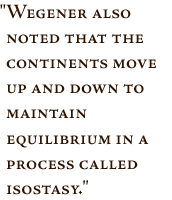

|
Wegener began by demolishing the theory that large land bridges had once connected the continents and had since sunk into the sea as part of a general cooling and contraction of the Earth. He pointed out that the continents are made of a different, less dense rock (granite) than the volcanic basalt that makes up the deep-sea floor in which Wegener proposed that the continents floated somewhat like icebergs in water. Wegener also noted that the continents move up and down to maintain equilibrium in a process called isostasy. As an example he cited the sinking of Northern Hemisphere lands under the weight of continental ice sheets in the last ice age, and their rise since the ice melted some 10,000 years ago. Given the difference in density between continents and sea floor, plus the process of isostasy, Wegener reasoned that if continent-size land bridges had existed and somehow been forced to the ocean bottom, they would have "bobbed-up" again when the force was released. Therefore, since fossil and geological evidence clearly showed the continents were once connected, the only logical alternative was that the continents themselves had been joined and had since drifted apart.
Wegener also offered a more plausible explanation for mountain ranges. According to the cooling, contracting-Earth theory, they formed on the Earth's crust as wrinkles form on the skin of a drying apple. If this were so, however, they should be spread evenly over the Earth; instead mountain ranges occur in narrow bands, usually at the edge of a continent. Wegener said they formed when the edge of a drifting continent crumpled and folded—as when India hit Asia and formed the Himalayas. He also noted that when you fit Africa and South America together, mountain ranges (and coal deposits) run uninterrupted across both continents, writing: It is just as if we were to refit the torn pieces of a newspaper by matching their edges and then check whether the lines of print ran smoothly across. If they do, there is nothing left but to conclude that the pieces were in fact joined in this way. By his third edition (1922), Wegener was citing geological evidence that some 300 million years ago all the continents had been joined in a supercontinent stretching from pole to pole. He called it Pangaea (all lands), and said it began to break up about 200 million years ago, when the continents started moving to their current positions. Perhaps the best summary of Wegener's revolutionary theory was provided by countryman Hans Cloos: "It placed an easily comprehensible, tremendously exciting structure of ideas upon a solid foundation. It released the continents from the Earth's core and transformed them into icebergs of gneiss [granite] on a sea of basalt. It let them float and drift, break apart and converge. Where they broke away, cracks, rifts, trenches remain; where they collided, ranges of folded mountains appear." next: The Wrath of Science
|
 On the Shoulders of Giants
| ||